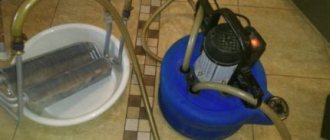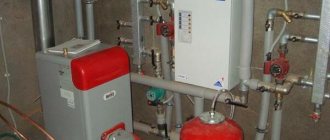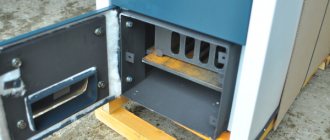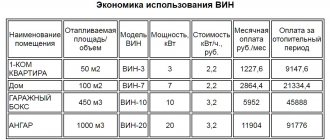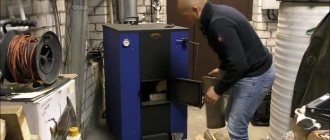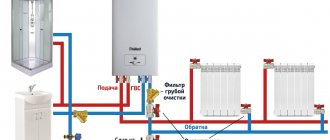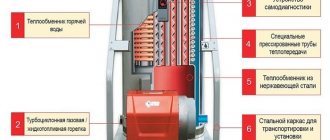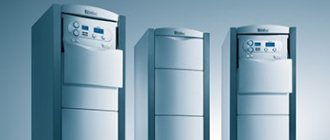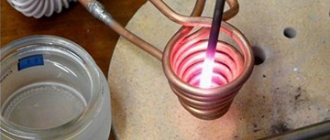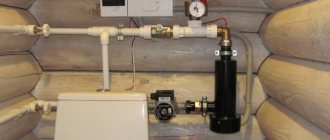Choosing between atmospheric and turbocharged boilers
When choosing an underfloor heating device, many are interested in the question of which unit is better to choose - atmospheric or turbocharged.
It depends on the conditions of use. A gas boiler with an atmospheric burner is suitable if:
- the need to heat a large area;
- under conditions of operation on several types of fuel;
- with frequent problems with power supply.
A turbocharged unit is selected when:
- inability to allocate a separate combustion chamber;
- small heating area;
- heating device for an apartment in an apartment building.
Another positive aspect of naturally aspirated units is their lower cost compared to turbocharged ones. If you choose a model with minimal equipment, it will be inexpensive.
Note! Atmospheric boilers are prohibited from being installed in an apartment in a multi-storey building.
Disadvantages of flue gas removal due to natural draft
Obviously, this method of removing combustion products in gas boilers has its drawbacks. In particular, the need to construct a chimney of the required height. The design of the chimney is also important. For example, a simple brick chimney will not be suitable for operating a gas boiler, since the steam contained in the combustion products will condense in the chimney, be absorbed into its walls and subsequently contribute to its destruction. To avoid this phenomenon, you will need to insert a liner made of stainless steel or polymer materials into the brick chimney.
In addition, it is necessary to ensure a constant unhindered supply of fresh air for combustion, which often leads to the formation of drafts that reduce the comfort of housing.
The disadvantage is the complexity of prompt and high-quality regulation of draft, as well as the dependence of draft both on weather conditions (air temperature, wind, etc.) and on external reasons (for example, turning on/off a kitchen hood, limited supply air, etc.). P.). When conditions that affect draft change, phenomena such as flame separation on the burner and reverse draft may occur. Therefore, when choosing a gas boiler with an atmospheric burner, it is necessary to pay attention to the availability of technical solutions that monitor and neutralize these undesirable phenomena (draft tipping sensor, flame control, etc.).
Single-circuit and double-circuit devices - what is the difference?
A single-circuit heating device differs from a double-circuit heating device only in that it is responsible only for heating the room. At the same time, a double-circuit boiler, in addition to heating, is also designed to solve issues of providing hot water supply.
Owners of single-circuit boilers solve DHW problems by installing additional equipment. Most often this is an indirect water heating boiler connected to the boiler. What is more efficient: a single-circuit boiler or a double-circuit boiler? We'll figure this out now.
The main advantage of a single-circuit boiler in conjunction with a storage heater is that water is heated to a comfortable temperature without cooling the home. Whereas, with significant water consumption in a double-circuit boiler, the circuit responsible for heating is automatically switched off, and the unit only works to heat the water.
A single-circuit gas boiler with an indirect heating boiler completely solves the issue of hot water supply without disrupting the operation of the heating system
The following factors should be considered before selecting a heater configuration:
- Heated housing area;
- Number of water intake points;
- Distance from water intake points to the boiler;
- Number of residents.
In a house with a small heated area, with economical consumption of hot water and close placement of water intake points, the optimal solution would be to install a double-circuit boiler.
If hot water is simultaneously consumed from several water intake points, the water temperature may be lower than required. In addition, with a large housing area, additional inconveniences arise. In double-circuit boilers, the priority is DHW; when hot water is consumed, the circuit responsible for heating is turned off.
But these issues are also resolved at the level of the unit design. There are double-circuit boilers that heat water in flow mode and are equipped with a built-in boiler.
The latter provide a supply of hot water of 30-60 liters, but at the same time gas consumption increases slightly. In addition, the weight of the boiler and its overall dimensions increase significantly.
A floor-standing gas boiler with a built-in indirect heating boiler provides an adequate supply of hot water
We can conclude that if the needs are met, the optimal solution would be to install a double-circuit flow-type boiler. If you want to have a sufficient supply of hot water at a comfortable temperature at any time without cooling your home, then it would be preferable to install a combination of a single-circuit boiler with an indirect heater.
In addition, if it is necessary to increase the need for hot water, the boiler can always be replaced with a larger capacity boiler. As a result, the price of such a combination will be higher than the cost of a double-circuit boiler, but the issue of hot water supply and heating will be reliably resolved.
Selection of heating equipment
When choosing the type of equipment, you should take into account the cost, technical characteristics, and reliability of the manufacturer.
Atmospheric boiler for home heating Source eurosantehnik.ru
To select the configuration of the unit, it is worth taking into account the area of the room, the number of water intake points, the distance from the heating device to the water intake points and the number of residents. A double-circuit unit can be installed in a building with a small area, economical water consumption and close proximity of water intake points. Large water consumption from several water intake points, as well as a large heated area, make it possible to install a unit with a built-in boiler; it heats water in flow-through mode.
Important characteristics that will help you make the right choice:
- Productivity, its average is 30 l/h. To calculate this value, you need to analyze the area of the room and determine the probable heat loss.
- The material of the heat exchanger determines the duration of use, the ability to conduct heat energy and the cost of the equipment. The primary circuit is made of steel or cast iron, the secondary circuit is made of copper and aluminum.
- Number of serviced circuits. To heat the room and heat the water, you will need a dual-circuit unit. Some types of double-circuit boilers have winter and summer modes. If you need to install a powerful and durable device, and the available space allows for its installation, you should give preference to a floor-standing unit. A single-circuit boiler is used exclusively for the production of thermal energy.
Vaillant equipment is distinguished by high quality characteristics at low cost. Inexpensive heating equipment is produced by Baxi, and Viessmann is famous for its high quality.
Pros and cons of atmospheric boilers
Heating atmospheric gas heating boilers have many advantages:
- the device is able to operate successfully even with low pressure fuel supply, including values up to 15 mbar;
- boiler equipment provides a wide range of loads;
- there is no need for additional air supply for optimal combustion of the gas mixture;
- The heating unit is distinguished by its simplicity of design, long service life, and low cost of replacing parts.
A definite significant plus for a boiler installation with an atmospheric burner is quiet operation.
Among the shortcomings of the equipment, the following points are noted:
- the operation of an atmospheric boiler requires an open type of air supply, this reduces the level of safety of operation of the device, since there is a risk of fire or release of carbon monoxide;
- at low gas pressure, the wear rate of fuel supply parts increases;
- Heating equipment of this category is installed in special rooms for the boiler room, which causes difficulties when arranging small houses and apartments.
The big disadvantage of the designs is the difficulty of high-quality draft control and dependence on external factors, including the weather outside (changes in wind direction, air temperature) and limited supply air.
Advantages and disadvantages of boilers with atmospheric burner
When choosing heating equipment, it is necessary to study the features of its operation.
The advantages of atmospheric heating technology include:
- Simple equipment design.
- Long service life.
- No noise during operation.
- Low costs for equipment repairs.
- Resistant to heavy loads.
- The equipment works well even when the fuel supply is poor.
Flaws:
- Possible fire or carbon monoxide release.
- The construction of a separate room for the boiler room is required.
- Low pressure leads to increased wear of parts.
Preference is given to this type of heating equipment in the following cases:
- A large area needs to be heated.
- It is assumed that different types of fuel will be used.
- It is not possible to connect the boiler to the electrical network.
In the event of emergency situations, lack of traction, or pressure drop, independent protocols shut down the unit. The monitoring electrical unit allows you to determine the presence of errors without disassembling the device. The security system includes sensors for hydrocarbons, temperature, flame, overheating and water level. The risk of unexpected unit shutdown is reduced by the self-diagnosis function.
Types of boilers
It’s worth starting with a brief analysis of the main types of boilers in order to understand the system of their operation and the appropriateness of installation in a particular home.
Floor and wall types of equipment
The floor structure is distinguished by its high weight - up to 100 kg. Its installation requires a lot of space, and installation is labor-intensive, complex and expensive. Most floor-standing atmospheric boilers do not heat water to be supplied to mixers. During operation, the floor-standing unit makes a lot of noise, and the chimney requires regular cleaning.
Positive sides:
- high power;
- durability;
- lack of electronics.
Wall heaters are smaller in size and weight (up to 50 kg). Such boilers are predominantly double-circuit. The model is easier to install and does not take up much space. The boiler can be placed anywhere in the room. Wall-mounted atmospheric boilers are single-circuit and double-circuit.
Both floor-mounted and wall-mounted boilers are produced to serve one or two circuits. However, if space allows, it is better to take two: a floor-mounted single-circuit one for heating and a column for preparing hot water
Disadvantage: a wall-mounted boiler depends on electronics. If something burns out, you will lose hot water and heating. Boilers are installed mainly in small apartments and houses.
Single-circuit and double-circuit
Single-circuit and double-circuit boilers differ in the tasks they can perform. So, for example, a double-circuit boiler (following the name) performs two tasks: it heats the room and heats water to be supplied to the mixer.
The single-circuit one performs only one standard function - heating.
A double-circuit boiler, in addition to its standard function, makes it possible to obtain hot water for various needs, but it cannot be called a full-fledged “boiler”. The fact is that the pressure of water that passes through the unit must be very strong for the system to work. Therefore, such a boiler needs to be installed near the bathroom and kitchen.
We recommend: Plate heating radiator: features of old steel appliances, video instructions and photos
A single-circuit boiler does not give you the additional function of a boiler, however, it costs several times less. The operating system of such a unit is simple, which means that if it breaks down it will be easier to repair. In addition to a single-circuit boiler, you can install an indirect heating boiler, which can operate on various fuels (gas, electricity, solid fuel), be floor-mounted or wall-mounted.
It works as follows: a central heating system is connected to the boiler (in a small circle); A flask with water is installed inside the unit, through which a coil passes. Hot water passing through the coil heats the water inside the boiler, and it can be used for personal purposes. When the heating is turned off, the taps at the inlet and outlet of the central heating pipes are closed, and the water in the boiler is heated using gas, electricity or solid fuel.
For more information on the structure and difference between single-circuit and double-circuit boilers, watch the video
Single-circuit gas boilers
Bosch GAZ 2500 F 30
An efficient and reliable boiler from a manufacturer whose name has stood the test of time
Expert rating: 93/100
A model that will not leave your home without heat even with voltage drops and a critical drop in pressure in the gas main. The large volume of the heat exchanger allows you to retain heat longer, which significantly extends the life of the burner by reducing the frequency of its activation.
Efficient and economical operation of the Bosch GAZ 2500 F 30 boiler is ensured by the burner modulation range from 60 to 100%. The operation of the unit is monitored using a large LCD display.
Specifications:
- Power – 30 kW;
- Room area – 300 m²;
- Efficiency – 92%;
- Installation option – floor;
- Weight – 137 kg;
- Dimensions – 1092×589×877 mm.
The boiler is very easy to control; already in the basic configuration there is a wide range of functions, which can be significantly expanded after the additional installation of room regulators.
This will allow you to work not only in weather-dependent mode, but also to use the weekly setting mode, regulating the room temperature throughout the day in automatic mode.
Advantages
- Modern automation
- Large heat exchanger volume
- Burner modulation range
- Stable operation when gas pressure decreases
- Resistance to voltage surges
- Thermal disinfection
- Preventing condensation
Flaws
- Heavy weight
- Energy dependence
Vaillant atmoTEC plus VU 280/5-5
A high-quality boiler that works flawlessly with low water pressure and gas pressure
Expert rating: 95/100
An excellent model for a reasonable price. The presence of a minimum side gap of 2 cm makes it easy to install a wall-mounted single-circuit atmospheric gas boiler as close to the wall as possible; operation in a residential area is possible.
The Vaillant atmoTEC plus VU 280/5-5 model has a high degree of safety, provided by protection against flame extinction, water boiling, lack of draft, and pressure reduction in the system. The copper heat exchanger quickly heats the water, and the bronze hydraulic elements guarantee long service life.
Specifications:
- Power – 28 kW;
- Room area – 230 m²;
- Efficiency – 91%;
- Installation option – wall-mounted;
- Weight – 95 kg;
- Dimensions – 800×440×338 mm.
The modern and stylish design of the wall-mounted boiler allows it to fit into the interior of any room. An intuitive control interface with display of operating mode and temperature makes it possible to easily control the operation of the device.
Advantages
- High security
- Silent operation
- Automatic self-diagnosis system
- Integrated eBus
- Partial power operation possible
- Convenient connection
Flaws
- Sensitivity to voltage changes
- Incorrect operation during emergency shutdown
Ferroli Pegasus D 32
Excellent boiler with advanced temperature control technology
Expert rating: 98/100
The boiler is controlled by a microprocessor with a digital interface. Economical fuel consumption and high efficiency are ensured by a heat exchanger made of stacked cast iron sections with ideal fin distribution.
The ease of control and management of the Ferroli Pegasus D 32 is due to the convenient user interface, all the necessary information is displayed on the LCD display. When installing a cascade controller, it is possible to create cascade systems.
Specifications:
- Power – 13-32 kW;
- Room area – 250 m²;
- Efficiency – 91.7%;
- Installation option – floor;
- Weight – 136 kg;
- Dimensions – 850×500×615 mm.
A compact boiler that can easily be built into a niche or kitchen. The geometry of the smoke channels and firebox guarantee virtually silent operation. Safety control is provided by a shut-off valve equipped with two thermostats.
Advantages
- Simple user interface
- Combustion control system
- Injection burner
- Economical fuel consumption
- Frost protection
- Self-diagnosis
Flaws
- No mechanical control system
- The heat exchanger is not protected from condensation
How to choose a location for installation
To understand which boiler is better, atmospheric or turbocharged, to use for a specific heating system, you need to understand some design features and the operating principle of the devices.
An atmospheric gas boiler can be wall-mounted or floor-mounted, as well as single-circuit, intended only for working with the home heating system, or double-circuit (with an additional coil) - for heating water.
In such a boiler, an open-type combustion chamber is installed, that is, air is taken in directly, in a natural way. It is precisely because of this feature that atmospheric installations are located in special boiler rooms, which, as a rule, is not a particular problem to equip in a private country house. But if it is planned to install a gas boiler in an apartment, then this factor becomes not only a disadvantage, but also an obstacle.
In addition, to remove combustion products, a traditional chimney with access to the roof of the building is required, which, again, is quite feasible in a private house, but difficult in an apartment building. Exceptions may be apartments of old construction with existing chimneys, which still need to be modernized over the years, but the percentage of such houses is small. If it is planned to install an atmospheric boiler in a country house, then in addition to the boiler room equipment, it will be necessary to design and install a chimney at the initial stage of construction, taking into account all the rules and regulations. It is imperative that the furnace room be equipped with an effective ventilation system that will ensure the flow of oxygen necessary for the combustion process.
Turbocharged gas boilers: how to choose, operating principle, advantages and disadvantages
A turbocharged gas boiler is a compact-sized boiler, which is usually mounted on a wall and has a closed gas combustion chamber and is intended for local water heating systems with forced circulation, photo 1.
Photo 1. Turbocharged boiler in the kitchen interior
Turbocharged gas boiler - tips for choosing, main features
This type of boiler is provided with an influx of oxygen using a forced draft fan through a two-channel chimney. One of the differences between this boiler and other types is the design of the chimney; the chimney consists of two pipes - a pipe in a pipe. Through an external pipe (larger diameter) air is supplied to the boiler, ensuring gas combustion, and through a smaller pipe (internal) smoke and gas combustion products exit, photo 2. Such boilers are often installed in cramped conditions, where it is not always possible to install a standard chimney system or in small buildings.
Turbocharged boilers can have different types of chimneys:
- vertical chimney;
- horizontal chimney;
- vertical two-channel chimney;
- connections to the chimney duct.
Basically, turbocharged boilers are produced as double-circuit boilers.
Photo 2. Chimneys of turbocharged boilers
Operating principle of a turbocharged boiler
A turbocharged boiler has a closed combustion chamber. Using a fan, air is supplied to the chamber through a coaxial chimney pipe (diameter of at least 110 mm) to maintain combustion of the gas supplied from the nozzles. The gas combustion products are removed by the turbine using a fan to the outside.
Such boilers are equipped with automation that allows you to automate the boiler operation process. The closed-type combustion chamber of wall-mounted turbocharged boilers is usually made of copper or its alloys. The chamber of floor-standing boilers is usually made of cast iron, which ensures longer operation of the boiler (20 - 30 years and above), and the service life of wall-mounted boilers is approximately 10 years and above.
Due to the use of a copper boiler chamber, in order to avoid rapid wear and burnout, such boilers are produced with low power - up to 35 kW.
Examples of the design and operating principle of turbocharged boilers are shown in photo 3.
Photo 3. Examples of the design of turbocharged boilers
Advantages of turbocharged gas boilers
- air for gas combustion comes from outside the house (from the street), and not from the room, the combustion chamber is sealed;
- no need to install a conventional vertical chimney;
- the ability to install the boiler in a non-residential area inside the house (pantry, kitchen, bathroom, etc.). There is no need to build a separate building (boiler room);
- compact dimensions of the boiler;
- Efficiency of turbocharged boilers is 90...95%, high energy savings (low gas consumption);
- high water heating performance (in 1 minute - 10...12 liters of hot water);
- electronic control system for the automation of the boiler operation process (not available in all types);
- high safety - there is no chance of carbon monoxide and unburnt monoxide entering the premises. The presence of automatic devices and sensors that monitor the operation of the boiler and are capable of emergency shutdown of the boiler;
- simplicity of the chimney pipe installation.
Disadvantages of turbocharged gas boilers
- high cost of the boiler and parts for repairs;
- dependence of the boiler operation on electricity.
The most common and high-quality turbocharged boilers are presented on the market by the following manufacturers:
- Ariston, Immergas, Baxi (Italy);
- Vaillant, Junkers (Germany),
Tips on how to choose the right turbocharged boiler
1. When choosing a boiler, you must proceed from the following data:
- size of living space and volume of heated premises;
- the amount of heat loss in the premises, which depends on the quality and thermal conductivity of walls, windows, floors and roofs. This parameter lies within the range of 90…250 W/m2. For a well-insulated building, this indicator is taken to be 100...110 W/m2;
- you should decide on the type of boiler: double-circuit (with additional water heating) or single-circuit (only for heating the building). In this case, you should take into account the intensity and amount of use of hot water. You can use the following data to determine the power of the boiler for heating water, based on the condition that all devices will be turned on at the same time:
Specific installation requirements
One of the important requirements for installing an atmospheric boiler is to ensure sufficient draft for complete combustion of the gas mixture with subsequent complete removal of combustion products from the room. According to regulatory and technical documents, equipment installation is carried out in compliance with the following recommendations:
- it is necessary to ensure the flow of an appropriate volume of air for gas combustion along with the organization of high-quality ventilation of the room;
- the cross-section of the chimney systems must correspond to the diameter of the smoke exhaust pipe of the boiler installation;
- According to the standard, the height of the accelerating (vertical) section of the smoke exhaust before the first turn must correspond to 2 d.
In addition, the required chimney height must be observed. According to the manual, the elevation of the pipe above the roof is:
- at least 0.5 m above a flat roof;
- at least 0.5 m above the ridge at a distance of up to 1.5 m from the ridge;
- not lower than the ridge if the pipe is located at a distance from 1.5 to 3 m from it.
If the chimney pipe is located at a distance of more than 3 m from the ridge, its height must correspond to a line drawn down from the ridge at an angle of 10° to the horizon.
The principle of natural traction
Removal of flue gases due to natural draft is traditional. This method of removing combustion products is inherent in many types of heating equipment using various types of fuel - from home wood stoves to large coal boiler units. The essence of this method of removing flue gases is that the density of the heated gas (for example, in a chimney) is less than the density of cold air outside, and, therefore, the pressure of the gas column in the chimney will also be less. As a result of the pressure difference, an influx of air from outside the room is formed, which, displacing hot flue gases, itself participates in the process of fuel combustion. This creates draft in the chimney. Moreover, the higher the chimney, and, consequently, the difference in pressure of the gas column in the chimney and outside it, the stronger the draft will be.
Basic criteria for choosing a boiler
When choosing a boiler with an atmospheric gas burner, you need to pay attention to the following main characteristics:
- Power;
- Number of circuits;
- Installation method: floor-mounted or wall-mounted;
- The material from which the heat exchanger is made;
- Automation and security
Let us dwell on each of the criteria in more detail, and consider all the main points associated with the given technical characteristics, with the exception of those that have already been discussed above.
Heating unit power
The quality of heating and the creation of a comfortable temperature in the room largely depend on the power of the boiler.
When calculating the boiler power, you need to take into account:
- Room area;
- Room volume;
- Thermal conductivity coefficient of walls, windows and doors.
In order not to dive deeply into numbers and calculations, you can take another, simpler route. It is generally accepted that to heat 10 square meters of housing, 1 kW of boiler power is sufficient for standard ceilings with a height of 2.5 m and insulation of the room. Thus, it is enough to divide the area of the room by 10, and we obtain the theoretically required boiler power.
The resulting figure must be increased by 20% to ensure normal operation of the boiler during peak load periods. To obtain a sufficient volume of hot water, which is especially important for flow-through double-circuit boilers, the power must be increased by 25%.
Material for the manufacture of heat exchanger
The main materials from which the heat exchanger of an atmospheric boiler is made are cast iron, steel, stainless steel and copper. A cast iron heat exchanger has almost no power limitations. It is reliable and durable, thanks to its excellent anti-corrosion properties.
But this also has its own characteristics - cast iron can crack due to the temperature difference at the point of water entry and the heating zone. Design solutions include the prevention of low temperature corrosion by installing a four-way valve.
Cast iron heat exchangers are installed in floor-standing boilers. The products are large in size and weight.
The cast iron heat exchanger has no restrictions on boiler power and is the most reliable and durable
Steel heat exchangers are used by domestic boiler manufacturers due to their low cost. Such heat exchangers do not require installation, they withstand thermal loads well, but at the same time they are significantly inferior to cast iron heat exchangers due to their low corrosion resistance.
A good alternative to steel is a stainless steel heat exchanger. It combines all the positive qualities of steel and cast iron - it is durable, immune to thermal shock, and has high corrosion resistance. But at the same time, boilers with stainless steel heat exchangers are more expensive.
Copper is flexible and conducts heat well. Heat exchangers made from it have many fins and are characterized by a small volume, due to which it is possible to reduce the size and weight of the boiler.
Copper heat exchangers are used in wall-mounted boilers, providing quick heating, which reduces fuel consumption. Due to its compact size and small amount of water, a circulation pump is required to avoid boiling.
Automation and security
Automation ensures safe operation of the boiler, economical fuel consumption, and helps increase the level of comfort when operating the equipment. The cost of automation for a gas boiler is determined by the number and complexity of programs and functions.
Some of them are considered basic and should be present in any gas boiler. They are responsible for preventing gas leaks as a result of various non-standard situations - flame extinction, drop in gas pressure.
There are two types of automation – volatile and non-volatile. The first is considered the most reliable, but requires a connection to the mains and an uninterruptible power supply. The second is considered mechanical, it is simpler and is autonomous.
We recommend: Connecting a heated floor - options, diagrams, step-by-step instructions
Non-volatile automation system
It is characterized by autonomy, high maintainability and low price. The temperature range of the thermostat is selected manually using a thermostat, which has a rod in its design that lengthens or shortens depending on the temperature. As a result, the gas supply valve opens and closes.
Non-volatile automation is easy to operate and ensures the operation of basic security systems
The basic automation package includes draft and flame sensors. When the draft decreases or the burner goes out, the gas supply is blocked. Although non-volatile automation is considered simple and reliable, it does not make it possible to operate the boiler in optimal modes, which reduces the service life of the equipment.
Volatile device version
Operating parameters or operating modes are entered on the display or from the remote control, after which the control and regulation systems are launched.
Energy-dependent automation extends the service life of equipment and opens up opportunities for wide comfort control functionality
The principle of its operation is based on the operation of solenoid valves, which are controlled by a microprocessor unit.
Main functions of modern automation:
- Temperature maintenance for a certain time;
- Adjustment of thermal conditions depending on the weather;
- Electronic flame modulation;
- Protection of the heat exchanger from overheating;
- System frost protection;
- Protection against jamming of the circulation pump;
- Self-diagnosis.
The disadvantage of the system is its energy dependence; in the absence of electricity, the equipment is blocked. To ensure full operation, the automation must be connected to an uninterruptible power supply.
How to choose a turbocharged gas boiler for heating a private home
Wall or floor
Wall-mounted models fit perfectly into the kitchen interior or can be completely hidden in a closet.
- floor-mounted ones are more versatile and durable, since the design is unlimited in weight; they often have durable cast iron heat exchangers installed.;
- mounted (wall-mounted) - compact and lightweight, medium and low power (10–50 kW) boiler units, often having greater efficiency than floor-standing models. However, due to weight requirements, they use less corrosion-resistant steel and copper heat exchangers.
In addition, wall-mounted boilers contain all the necessary heating system modules in one housing (expansion tank, circulation pump, safety valve, air vent, etc.), which not only simplifies, but also makes installation cheaper. Floor-standing models are rarely equipped with all the necessary modules.
Single-circuit or double-circuit
The functionality of a turbo boiler is determined by the number of circuits:
- single-circuit - its capabilities are limited exclusively to heating;
- double-circuit - along with heating, it heats water for domestic needs.
A double-circuit boiler is a combination of a boiler and a flow-through heater, i.e. heating of the room stops while hot water is supplied. It is worth clarifying that, contrary to popular belief, the coolant does not have time to cool down during downtime, so the temperature in the home remains unchanged.
Heat exchanger type and material
A copper heat exchanger is the most optimal option for a wall-mounted model. The heat exchanger material affects the durability of the boiler:
- cast iron (service life 25–30 years or more) is the most heat- and corrosion-resistant metal, but fragile and heavy, therefore it is used only in floor-standing models;
- copper (service life 12–17 years) is a very light and thermally conductive metal (it heats up and cools down quickly), is slightly susceptible to corrosion, but can burn out.
- steel (service life 10–15 years) - metal tolerates transportation well, because it is not sensitive to physical impact, lightweight and inexpensive to produce, but is prone to rust, which leads to leakage over the years.
Double-circuit boilers are also divided according to the type of heat exchanger: separate (one for each circuit) and dual - bithermic (the hot water circuit passes through the main heat exchanger). The latter option is cheaper, but it is less reliable, because the scale formed in it is almost impossible to clean, and it is clogging with scale that often becomes the cause of premature failure.
Efficiency
Despite the fact that the “pure” efficiency of the atmospheric (90–92%) and turbo boiler (92–95%) is almost the same, the second will have higher gas consumption efficiency.
The point is in using a coaxial chimney: when cold air from the street enters its external cavity, it begins to heat up even before entering the combustion chamber from the heat of the smoke (100–130 °C), which exits through the internal cavity of the same pipe. Therefore, less resources are spent on further heating. It’s also worth adding more efficient control of air flow and draft, which also affects gas consumption.
Minimum required power
You can calculate the required power of a turbo boiler using a simple formula: where 1* kW of energy is consumed per 10 m2 of heated area.
* heat loss of an average residential property with ceilings up to 2.7 m from central Russia.
We recommend setting aside a margin of 15–20% of this value so as not to operate the unit at the limit, so for the same object Q≈14–15 kW.
Also, if we consider a two-circuit model, then we will have to add at least 15–20% for the use of hot water supply, so in total it will turn out that Q≈16–17 kW
It is also important not to overdo it with power, otherwise the boiler will “clock” too often (turn on and off), which will reduce its resource
How to accurately calculate the required boiler power Individual calculation, formula and correction factors
How to calculate the optimal value of the thermal power of a gas boiler?
Why buy a boiler more powerful than required if this will certainly lead to unnecessary costs not only at the time of purchase, but also during operation. On the other hand, giving away a lot of money and freezing in the winter, washing your face with cold or lukewarm water is, to put it in TV serial language, a loss of losses!
The simplest method for selecting the golden mean: 1 kW per 10 m² of serviced area. However, this is very approximate and some important parameters are not taken into account. For example, such as: the climatic coefficient of a particular region, the degree of thermal insulation of the walls, the level of probable heat loss, the volume (and not just the area) of the room, etc.
This means that a more accurate calculation is needed. There are two ways: use publicly available formulas that take into account the above criteria (you have the opportunity to remember your school years) or act more rationally and use a special calculator, which are a dime a dozen on the Internet.
Power calculation formula
Performing a full calculation of the power of a heating system is difficult and beyond the power of a person who does not have special training. However, there is an easy way to determine power.
It has been experimentally determined that heating 10 m2 of area requires 1 kW of thermal energy. This means that a 24 kW boiler is designed to heat a house of 240 m2, and a room of 150 m2 will require 15 kW of power.
Guided by this ratio, you can quickly and accurately select the right boiler . It is necessary to take into account that it is impossible to make a large reserve of power - the unit will operate abnormally, which will cause the burner to constantly turn on and off.
This mode will create conditions for rapid failure of important components and parts of the boiler.
What to look for when choosing a gas boiler
There are many boiler selection criteria that you can consider before purchasing. If you don’t know enough about the issue, then a smart decision would be to read customer reviews and find out the opinions of experts. If you want to figure it out yourself, then you need to consider the following parameters:
- type of gas boiler (floor-standing, wall-mounted);
- heat exchanger material (steel, cast iron, copper);
- number of circuits;
- installation features;
- serviced area;
- energy dependence;
- power and so on.
Also pay attention to the conditions of use. An apartment and a country house, a store and an office, a warehouse and other facilities will require different gas boilers.
The best wall-mounted atmospheric gas boilers
Lines from Italy, Korea, and the Czech Republic are considered industry leaders; world-famous brands provide a wide range of items.
BaxiECO4s
The Italian brand offers a range of wall-mounted atmospheric boilers with advanced electronic filling. Heating equipment is made in accordance with environmental safety requirements. Baxi units have an ergonomic design and are distinguished by their reliability, ease of installation and maintenance.
BaxiECO4s24
The model is on the list of top sellers for 2021. The device is a double-circuit unit with an open combustion chamber, power 9.3-26.3 kW, heated area up to 240 m². The cost varies between 33,500-36,000 rubles.
BaxiECO5 Compact1.24
The fifth generation wall-mounted model is presented in the economy class category. Single-circuit boiler, power 9.3-26.3 kW, dimensions 730x400x298, cost from 31,000 rubles.
Dakon
The products of the Czech manufacturer are designed to help solve problems with home heating and hot water supply. DakonGLEco cast iron models with an atmospheric ejection burner are of particular consumer interest. The equipment is equipped with Honeywell electronics, a draft breaker, and additional additions are provided in the form of room thermostats, external sensors, and antifreeze devices.
NavienAce
The Korean brand offers wall-mounted atmospheric boilers that do not respond to voltage changes and function perfectly in the range of 155-220 volts. The unit is capable of operating at low pressure of gas fuel (within 4-16 mbar) and water (0.1 bar). The minimal dimensions and relative accessibility of the equipment also attract attention. NavienAceATMO double-circuit wall-mounted boilers are equipped with a natural system for removing combustion products, a chip that is triggered by changes in network voltage, and an automatic system that turns on the pump when the temperature drops to 10°C.
Operating principle and design of a turbocharged boiler
The main components of the unit are:
- Gas burner mechanism. This is a composite product. It includes a forced-air burner, a fuel supply solenoid valve and a flame sensor.
- Electronic ignition device.
- Heat exchanger with pipes for connection to the heating circuit. Located above the burner.
- Fan or turbine.
- Automation system.
- Thermally insulated housing.
The combustion chamber of turbocharged boilers is closed, i.e. it has no communication with the premises. The air necessary to maintain combustion comes from outside through a special channel.
To overcome its aerodynamic resistance, natural thrust is not enough, so a fan is used. At the same time, it ensures forced removal of combustion products.
The blower rotation speed is adjusted by the controller depending on the current heating output. The air duct and smoke channel are combined in the form of a coaxial pipe. Its internal volume is used to remove combustion products. Air passes into the gap between the walls.
The main function of the boiler is to heat the working medium flowing through the heat exchanger. Its temperature is controlled by a sensor. Based on its signal, the burner lights or goes out.
In addition to the main components, many models are equipped with elements of the heating system:
- Circulation pump.
- Expansion tank.
- Pressure gauge, air vent and safety valve. Collectively, these elements are called a security group.
The owner of this model gets rid of the need to purchase additional equipment. You just need to connect the heating circuit pipes to the unit.
The best floor-standing atmospheric boilers
This segment presents samples of domestic production, Italian and German series.
BaxiSlimEF1.22
The power of the device is 22 kW, the device is optimal for heating an area of up to 200 m², dimensions 850x400x595, sold at a price of 52,000 rubles.
BaxiSlimEF1.61
Model with a power of 60.7 kW, heated area up to 580 m², dimensions 850x400x870, cost within 84,000 rubles.
TitanN30E
Single-circuit non-volatile device with a power of 24 kW, heated area up to 280 m², dimensions 940x295x570, cost varies between 38,000-40,000 rubles.
TitanZ30E
Domestic floor-standing gas installations of the TitanZ series are designed to service autonomous systems with coolant pressure up to 0.3 MPa. The TitanZ30E model with a power of 22 kW of single-circuit design is capable of heating an area of up to 220 m², unit dimensions are 940x295x570, the products are sold at a price of 39,500-41,900 rubles.
RodaKrafterEvoRmod30
The model is single-circuit, belongs to the list of top sellers in 2021. The power of the unit is 31.2 kW, the potential of the heating device is designed to serve an area of up to 300 m², the heat exchanger is cast iron sectional, dimensions 910x450x475, cost from 61,000 rubles.
RodaKrafterEvoRmod60
A new modification of the device with a power of 60.5 kW, a single-circuit model with a sectional cast-iron heat exchanger, is capable of heating an area of up to 550 m². Dimensions 910x450x700, product cost from 83,000 rubles.
comparison table
When choosing a gas boiler for an apartment or house, you should first of all proceed from its technical characteristics. You can compare them using our table.
Model Thermal power, W Efficiency, % Volume of expansion tank, l Natural gas consumption, cubic m/hour Average price, rub.
| Navien DELUXE 13K | 7–13 | 91,7 | 6 | 1,4 | 31 774 |
| Buderus Logamax U072-12K | 5,4–12 | 92 | 8 | 2,1 | 36 995 |
| Bosch Gaz 6000 W WBN 6000-18 C | 5,4–18 | 93 | 2,1 | 35 065 | |
| BAXI ECO-4s 24F | 9,3–24 | 92,9 | 6 | 2,73 | 36 339 |
| Lemax PRIME-V20 | 9–20 | 92,5 | 2,27 | 35 857 | |
| Viessmann Vitopend 100-W A1JB010 | 24 | 91 | 2,77 | 39 227 | |
| Vaillant turboFIT VUW 242/5-2 | 9,7–23,7 | 93,5 | 7 | 2,66 | 39 828 |
| Ariston CARES X 24 FF NG | 11–25,8 | 93,7 | 8 | 2 | 38 025 |
| Protherm Cheetah 23 MTV | 9–24,6 | 93,2 | 5 | 2,9 | 41 568 |
| BAXI LUNA-3 240 Fi | 9,3–25 | 92,9 | 8 | 2,84 | 67 526 |
What is the difference between turbocharged gas boilers and atmospheric ones?
18.08.2016
Differences between turbocharged gas boilers and atmospheric ones.
Each type of gas boiler is designed for a specific room. Since boilers are the main type of heating equipment in many homes, let’s figure out how to choose them correctly. Gas boilers are very convenient and practical because, firstly, gas is a relatively inexpensive fuel, and secondly, such boilers have a high percentage of efficiency.
The atmospheric boiler is equipped with an open combustion chamber; exhaust gases exit naturally through the chimney. But in order for the flame not to extinguish the oxygen it consumes from the room.
Installing an atmospheric boiler is a rather labor-intensive process:
- You need space, it can be a separate boiler room or a spacious room.
- The chimney must be routed vertically through the roof in order to provide natural exhaust.
- This room should be well ventilated so that there is always a flow of fresh air.
Yes, atmospheric (open) boilers are much cheaper than turbocharged ones, but if they are well manufactured and assembled, then they can be more expensive than many simple turbocharged ones.
A turbocharged gas boiler (open chamber) is modern equipment with more advanced equipment. It includes: a fan that forces air into the combustion chamber.
Turbocharged gas boilers can be:
- with coaxial chimney;
- with separate chimney.
A coaxial pipe is two pipes, one larger in diameter, the second smaller, located one inside the other. Air enters the boiler along a large radius, and exhaust gases exit along a smaller radius.
Boilers with a closed combustion chamber have a number of advantages compared to open ones: air is taken from the street, thereby not creating a danger that during combustion dangerous gases will enter the room. — during installation, a turbocharged boiler does not require a chimney. The air is drawn out forcibly using a fan. - high coefficient of total action. - safe operation of the boiler, provides a number of advantages, it can be installed in any room.
Unfortunately, turbocharged boilers cost more, but as they say, “You have to pay for convenience”
This figure shows in more detail what a coaxial chimney is.
www.conditioned-m.com
